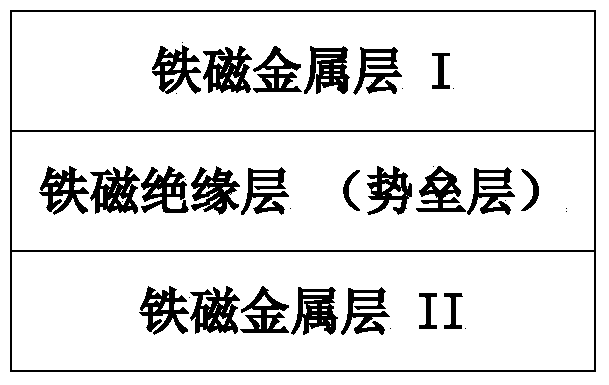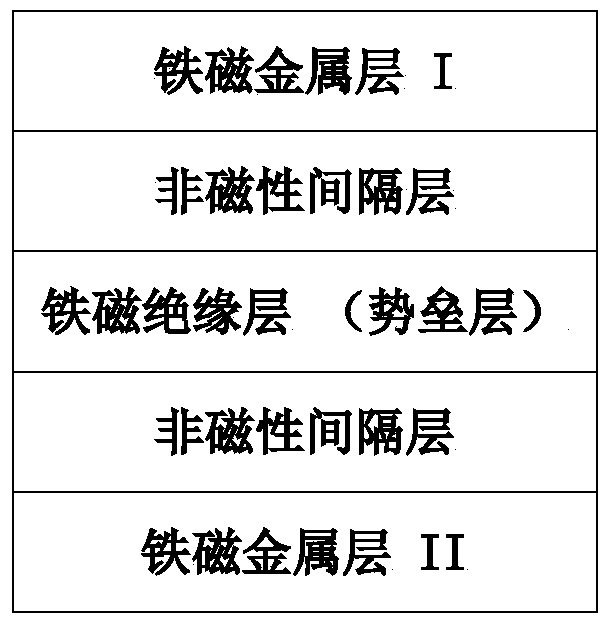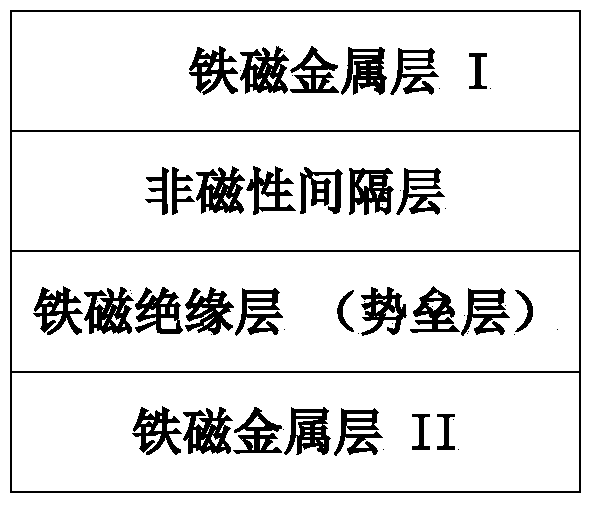Magnetic Tunnel Junction Based on Ferromagnetic Insulator
A magnetic tunnel junction and insulator technology, applied in the field of non-volatile memory, can solve problems such as large lattice mismatch, interfacial dislocation and potential barrier defects
- Summary
- Abstract
- Description
- Claims
- Application Information
AI Technical Summary
Problems solved by technology
Method used
Image
Examples
Embodiment 1
[0034] Embodiment 1: as figure 1 , is a structural schematic diagram of a novel MTJ (magnetic tunnel junction) based on a ferromagnetic insulating material as a barrier layer;
[0035]Compared with the traditional MTJ based on the barrier layer of non-magnetic insulator (such as MgO, Al2O3, etc.), the novel MTJ of the present invention uses ferromagnetic insulator as the tunneling barrier layer. The new MTJ core layer structure is composed of ferromagnetic layer I (0-3nm), ferromagnetic insulating layer (0-5nm), and ferromagnetic layer II (0-3nm) from top to bottom; the magnetization direction of each layer can be Parallel to the plane, or all along the vertical direction. The magnetization direction of one layer (reference layer) of the ferromagnetic layer I and ferromagnetic layer II is fixed, and the magnetization direction of the other layer (free layer) can be reversed in a certain way, so that the two layers can be parallel or antiparallel of the two states. Methods t...
Embodiment 2
[0037] Embodiment 2 is a novel MTJ (magnetic tunnel junction) based on a ferromagnetic insulating material as a barrier layer and a non-magnetic spacer layer; the structure consists of a ferromagnetic metal layer 1 (0-3nm) from top to bottom, Nonmagnetic spacer layer (0-3nm), ferromagnetic insulating layer (0-5nm), nonmagnetic spacer layer (0-3nm), ferromagnetic metal layer II (0-3nm) ( Figure 2a ); wherein the ferromagnetic metal layer I, the ferromagnetic metal layer II and the ferromagnetic insulating layer are the same as in Embodiment 1, and a nonmagnetic spacer layer is added between the ferromagnetic metal layer I, the ferromagnetic metal layer II and the ferromagnetic insulating layer , separate them to avoid coupling between two ferromagnetic metal layers in some material systems through a ferromagnetic insulating layer, so that their magnetization directions cannot be separated, and it is impossible to distinguish between parallel and antiparallel magnetization direc...
Embodiment 3
[0039] Embodiment 3 is a novel MTJ (Magnetic Tunnel Junction) based on a ferromagnetic insulating material and adding a heavy metal layer according to the present invention. The structure consists of a ferromagnetic metal layer (0-3nm), a ferromagnetic insulating layer (0-5nm), and a heavy metal layer (0-5nm) from top to bottom ( Figure 3a ); Another structure based on this is to add a non-magnetic spacer layer between the ferromagnetic metal layer and the ferromagnetic insulating layer ( Figure 3b ), to separate them to avoid the coupling effect of the two magnetic layers in some material systems, so that the magnetization directions cannot be separated.
[0040] In this example, the material of the ferromagnetic layer is Co, which is used as a reference layer; the ferromagnetic insulator is YIG, which is used as a barrier layer and also serves as a free layer for inversion; the heavy metal layer is Pt.
PUM
 Login to View More
Login to View More Abstract
Description
Claims
Application Information
 Login to View More
Login to View More - R&D
- Intellectual Property
- Life Sciences
- Materials
- Tech Scout
- Unparalleled Data Quality
- Higher Quality Content
- 60% Fewer Hallucinations
Browse by: Latest US Patents, China's latest patents, Technical Efficacy Thesaurus, Application Domain, Technology Topic, Popular Technical Reports.
© 2025 PatSnap. All rights reserved.Legal|Privacy policy|Modern Slavery Act Transparency Statement|Sitemap|About US| Contact US: help@patsnap.com



